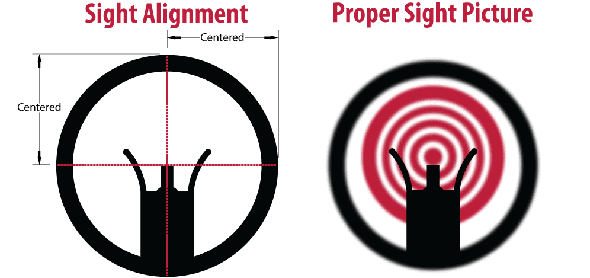This is My Rifle, This is My Gun
While I did have limited experience with firearms in my youth from casual experiences in hunting and even competition shooting, my personal history with firearms really didn't begin until I enlisted in the United States Marine Corps during the late Nineties.
I had the best ASVAB[1] score one can get and had my pick of MOS[2], but my color blindness prevented me from doing much of the occupations that had initially caught my eye. I had even aced the Navy's nuclear propulsion tests and was initially signing on as a submarine squid until I had my MEPS[3] physical and discovered I was colorblind, much to my surprise (I had a reputation for being an artist).
It was at this point I decided that if I was going to enlist in a service, I should pick the best of the best. There's only one branch that fit the bill, and they were the few, the proud, the Marines. That, and the Corps definitely had the best looking uniforms. So I walked across the hall to speak with the leathernecks and asked what the most exciting occupational specialty available to me was.
The recruiter informed me about the Marine Corps Security Forces[4] and basically billed them as the S.W.A.T. team of the Corps... which was sort of true, but he forgot to mention that most MCSF jarheads spend all of their time standing post (i.e. walking the fence, guarding gates, etc.). But he sold me on it and my options were thin, and I wasn't going to be a clerk or a cook.
Of course, MCSF isn't exactly a primary MOS, or military occupational specialty; it's a secondary. My primary MOS would be 0341, or mortarman. During Basic and Infantry training, I became well acquainted with both the M16[5] assault rifle as well as the M9[6] pistol. The Marines have a very successful marksmanship program, and I eventually went on to become a marksmanship coach.
Because of my MCSF and heavy weapons background, I'm familiar with a wide array of weapons beyond the standard issue rifle and pistol including: Mossberg M590[7] & Remington M870[8] shotguns, HK MP5[9] submachine gun, FN M249[10] SAW, FN M240G[11] machine gun, Browning M2[12] machine gun, GD Mk19[13] automatic grenade launcher, IMI SMAW[14], M252[15] 81mm mortar, and last, but not least, the M224[16] 60mm mortar (the heavy weapon I have the most experience with).
Towards the end of my enlistment, I picked up another secondary MOS as a Marksmanship Coach. At one period of time, I was running 300 Marines at a time through rifle qualifications. I spent many months at Stone Bay Rifle Range helping Marines zero their rifles and get on target. I spent several more directing lines of fire as the Tower NCO.
Those four short (in hindsight) and honorable years of service left me not only with significant training and application of squad tactics, hand-to-hand, non-lethal/riot control, CQB[17], MOUT[18], and marksmanship, it also instilled a healthy respect for the deadly capabilities of the firearm, it's history, and it's dual role as both a usurper and defender of liberty.
These days I tend to be an aficionado of American Old West firearms and often shoot things chambered in .45 Colt with mid 19th century designs (lever action rifles & single action revolvers). I only mention these things to illuminate my long and intensive relationship with the firearm.
An Inalienable Right?
in·al·ien·a·ble /inˈālēənəbəl/I'm not totally convinced the right to bear arms is an inalienable right in the sense that it is something that should never be taken away from a person. I think it's inalienable from the perspective of society, but I can certainly see situations where an individual can, and should, be stripped of the right to carry or own firearms. I see a need for legislation that allows us to make it difficult for the wrong people to legally obtain and carry firearms as well as vigorously prosecute those who unlawfully operate firearms
adjective: Unable to be taken away from or given away by the possessor: "inalienable human rights."
However, I think the Second Amendment[20] of the Constitution of the United States of America is vital for our liberty. This concept goes beyond the individual hunting, sporting, or self-defense precepts. The right of the people to bear arms ensures our ability as citizens to protect our liberty against the tyranny of a government that no longer has its people's best interests at heart.
I think the gravity of the responsibility that the Second Amendment places upon the people is often lost on the pro-firearm community. Yes, our community quickly froths at the mouth at the mere mention of limitation upon our rights to own and carry, but I feel that many fail to understand the big picture and refuse to understand where our opponents are coming from. It is a problem that exists on both sides of the battlefield, but is far worse with gun-rights activists, which prevents rational discourse and leads to behavior and labels unbecoming of the otherwise well-meaning citizens dug in on both sides.
Hoplophile's Requirements of Responsible Firearm Ownership
I think it behooves the firearm community to embrace a standard of responsibility among ourselves and hold each other to these standards. I have drafted four simple requirements that responsible firearm owners should meet. If you can't abide by these simple rules, maybe you shouldn't own a firearm.
- Respect firearms' capacity for deadliness
- Understand proper operation, maintenance, & care of your firearms
- Practice the fundamentals of marksmanship with your firearms
- Engage in appropriate activities with your firearms
To do anything less would be irresponsible firearm ownership and I would not object to the State stripping your right to possess or carry firearms away from you... after due process, of course.
Hoplophile's Guidelines for Competent Hoplophilia
- Research the history, the laws, & the data
- Understand the opposing viewpoint
- Study the logic of arguments & debating
- Teach & inform your fellow firearm owners
- Articulate your point civilly
Research, Research, Research
In order to know the issue, you're going to have to research. You cannot rely on the words of your friends, family, or Fox News. Research. Read the legislation and the laws for yourself. Read about the history of firearms and of conflict in general. Understand how superior firepower, tactics, and strategy dictate history. See and interpret the data yourself.
This might need to be its own Guideline, but don't lie to yourself. Do not twist data or make uninformed hypotheses just to fit your needs and agenda. This is the most important part of research. Research your feelings and really understand why you have the opinion you do. Keep diving down by asking yourself "why" until you get to the bottom.
Play the Devil's Advocate
We need to understand the opposing viewpoint. What is the underlying goal of their stance? Research again, only this time gather evidence that supports their argument. Try to convince yourself that their argument has merit, your argument will either become stronger or it will crumble. If it crumbles, then maybe you need to abandon that argument.
Apply Logic, Avoid Fallacies
Know how to create compelling arguments while eliminating logical fallacies[22] from them. Identify problems common in arguments from the community and fix your own. Test your arguments against what you learned from researching the opposition's stance. Do not appeal to emotion. Do not create red herrings.
Spread Information & Improve the Community
Don't stop with yourself; be sure to eliminate misinformation in the community. Pass along current events and developments in legislation. Contact your congressmen. Improve the voice of the community by calling out fallacious arguments. Don't let our easily-riled compatriots rage on opponents; ensure everyone keeps the discussion civil.
Maintain Your Composure
Don't shout at people (and don't write in all-caps). Don't feed the trolls and spell/grammar check your written statements. Don't try to intimidate fellow citizens who disagree with you. These people are our neighbors, friends, and family.
Reloading
I enjoy firearms and would like to be able to continue this little hobby I call hoplophilia. Help us keep our right to bear arms by being a responsible and competent firearm owner. I hope this has given you a taste of the kinds of things I want to do with this tool and you want to read more. Keep your sights on target, I'll be back with more.
References
[1] ASVAB is the acronym for the Armed Services Vocational Aptitude Battery. A test administered to determine qualification for enlistment.
[2] MOS, or Military Occupation Specialties are codes that categorize career fields.
[3] MEPS, or Military Entrance Processing Station is where medical pre-screens and contract signing occur.
[4] Marine Corps Security Forces provide force protect and anti-terrorism for high value naval installations.
[5] The Colt M16 was the standard issue rifle of the United States military during my service. It fires a 5.56x45mm NATO cartridge.
[6] The Beretta M9 pistol is currently the standard issue sidearm of the United States military. It fires a 9x19mm Parabellum cartridge.
[7] The 12 gauge Mossberg M590 is a shotgun still in service with the United States military.
[8] The 12 gauge Remington M870 is another shotgun still in service with the United States military.
[9] Heckler & Kock's MP5 is a submachine gun that uses the same round as the M9.
[10] The Fabrique Nationale M249 Squad Automatic Weapon is a light machine gun in service with the US Military. It utilizes the same round as the M16 but is belt fed.
[11] The FN M240G currently sees service as a crew-served medium machine gun in the US military. It fires the 7.62x54mm NATO cartridge.
[12] The Browning M2 heavy machine gun, firing the massive .50 BMG cartridge, has been in service with the US military since 1933.
[13] The Mk19 is a crew-served, belt-fed automatic grenade launcher in service with the US military.
[14] The SMAW, or Shoulder-launched Multipurpose Assault Weapon, is a rocket launcher primarily used for busting bunkers and secondarily against armor.
[15] The M252 mortar is a smooth bore, muzzle-loading, high angle of fire weapon used for indirect fire.
[16] The M224 is the M252's little brother and even shares the same sight unit.
[17] CQB is an acronym for Close Quarters Battles and is comparable to SWAT of civilian police.
[18] MOUT is an acronym for Military Operations in Urban Terrain.
[19] PTSD is yet another acronym standing for Post-Traumatic Stress Disorder, a common issue among veterans.
[20] The Second Amendment to the United States Constitution states: "A well regulated militia being necessary to the security of a free state, the right of the people to keep and bear arms shall not be infringed."
[21] RTFM stands for Read The Fucking Manual... do you like acronyms yet?
[22] Logical fallacies are improper reasoning and argumentation... which usually happens when someone has not done their research or becomes enraged.









































